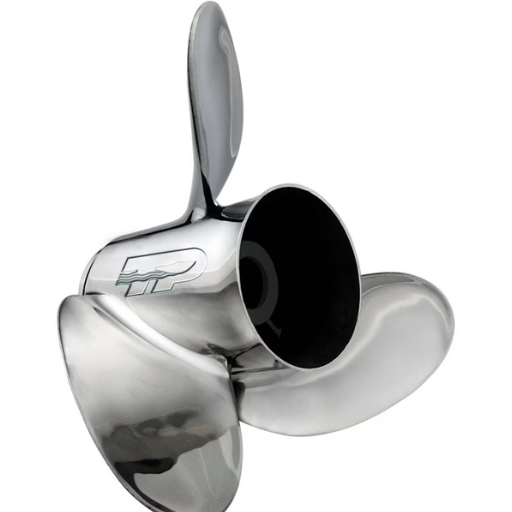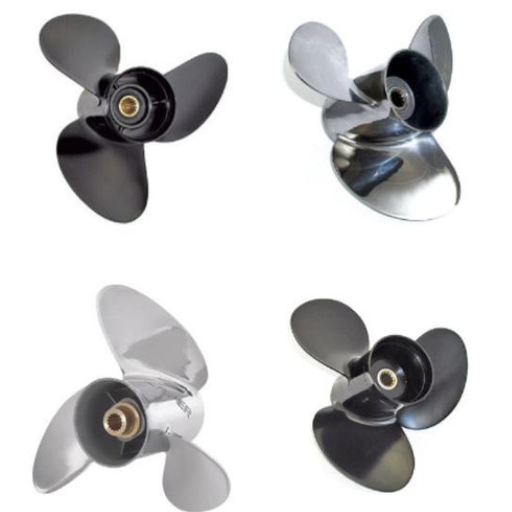The type of propeller fitted on a boat is important because it determines the overall performance, efficiency, and longevity of that boat. This blog focuses on the use of aluminum propellers and stainless steel and tries to provide the reasons why one metal should be chosen over the other. One of the main reasons why aluminum propellers are popular is the cost, the low weight limitations also make them the best option in sailboats and casual boating. On the other hand, stainless steel propellers on the other hand are preferred in more demanding situations as they provide much higher performance and are able to withstand harsh conditions. We will examine both aspects of the material and its application starting from the core – the areas of usage so you can choose what suits your needs and preferences. In case this is not your first time purchasing a new or upgrading the current propeller, the knowledge you gain here will be helpful in altering the boat specifications’ to their maximum.
What is the Difference Between Stainless steel vs aluminum propellers?

The main differences between stainless steel and aluminum propellers lie in their properties, their functions, and the costs. Due to their properties, stainless steel propellers are normally tougher and more resilient making them ideal for rough conditions, which need strength. They are also relatively designed to perform better as they can maintain their shape under stress. However, their cost is higher than aluminum alternatives. Aluminium is preferred because they are lightweight and inexpensive which makes them ideal for recreational boating and small boats. But for demanding boats, their performance may not be that effective but for most boaters, they are affordable and easy to replace.
Understanding Prop Material
Aluminum or stainless steel? Each boat expert is bound to have their own opinion, but I have come to realize these particular materials have unique attributes that are both advantageous and disadvantageous. High performance and super strength combined with somewhat expensive price tags are the traits of stainless steel propellers that remain “the strongest weapon” even in the harshest conditions. Experts say this is ideal for anyone wishing to have propellers that can perform for long durations without losing their effectiveness. Aluminum props on the other hand, are cheap and light in weight so unlike enthusiasts, casual boaters will have great use for them since they do not have to worry about the cost. They may not last long or withstand extreme conditions no matter how tough they are, but their short lifespan PLUS inexpensive replacement cost makes them a popular option among casual boaters. In conclusion, my choice will be based on the way I am likely to use the vessel and how much I am going to spend on it that is.
Key Features of Stainless Steel Propellers
Looking at the fundamental specifications, one of the most important is the lifetime. Their shape retention and ability to withstand the effects of abrasion make them quite suitable for extreme and rough water applications. I value their effectiveness especially since they are usually more fuel-efficient and provide greater speed because of their more slender and hydrodynamic blades. Stainless steel propellers, although much more expensive, seem to be worth the long-term expenditure for people aiming for consistency and solid effectiveness in various boating conditions. The extra mass of these propellers further aids in increasing the momentum which can help in sustaining speed in more aggressive scenarios.
Characteristics of aluminum propellers
The most appealing features and the main considerations when thinking about aluminum props are the price and the availability of these props. As easy as it sounds, these propellers are light and comfortable to use which makes them ideal for the leisure ones, occasional boater as I am. They are relatively inexpensive and thus make an effective solution for people looking for a replacement prop or spare propeller due to financial limitations. One has the impression that these are easily available and if required to change them can be so without making large investments, thus the factor of repair and replacement sounds good. Of course, they do not perform as well as the top-end performance offered by a stainless steel propeller, however, for my sail in quiet waters, aluminum props are good enough for normal use.
Which is Better for My Boat: Stainless steel vs aluminum propellers?

My preference for either aluminum or stainless steel propellers for my boat depends on what I need with the boat and how I expect to use it. On the other hand, if lack of money and simple usage is the main issue, aluminum blades should do the trick. They are inexpensive, can be easily substituted, and are best fit for light in observing the sea. On the contrary, if my boat is used in the majority of the time at high speeds, through turbulent water, then stainless steel propeller is much better. They are more expensive but their resistance, power and overall performance in such conditions is worth the price. All in all, it all depends in balancing the requirements of performance and financial aspects which will lead me to the best solution for my boating escapades.
Advantages of Aluminum Props
As opposed to stainless steel propellers, aluminum propellers provide several advantages. For one, they are much cheaper and that is a very big factor considering I work on a budget. They are also not as heavy as the stainless steel propellers which makes them easier to handle and install which is great for me since I take the boat out sometimes. Further, if they are damaged or broken, aluminum props can be replaced or repaired easily and affordably because they are in abundance. This is particularly useful for leisure trips into smooth waters where performance does not really matter.
Benefits of Stainless Steel Props
In my opinion, stainless steel propellers are great for more strenuous boating activities. It’s fabricated or designed in a way that enhances durability and damage resistance, making it appropriate for harsher navigational conditions or shallow waters infested with wreckages. The advantage of this strength is that it can sustain impacts that would otherwise disfigure aluminum props, thus eliminating the burden of constant repairs. Moreover, stainless steel props are the most effective of them all in terms of performance. They enhance performance and allow better acceleration and top speed since they allow less flexing under tension. True, stainless Steel props are expensive, but within the first few years of its usage, it more than pays for itself when used on harsh boating applications.
Factors to Consider in Choosing a Prop
While selecting a prop for my boat, First of all, material is important, for example, aluminum props are cheaper and useful for occasional usage on calm waters while stainless steel props are tougher and will perform better in harsher conditions. Secondly, the size and pitch of the prop must be specified, for example, a higher pitch prop is recommended for speed performance while a prop with a lower pitch increases acceleration and pulling power based on technical parameters supplied by industry contractors. Furthermore, taking the engine’s RPM range into account is essential, for the appropriate one prop should be selected that allows the engine to work in the desirable RPM range in efficiency and safety conditions. Last but not least, the purpose and environment also matter, if I work mainly in shallow waters with obstructions or open sea then the preferred prop will differ considerably. These factors ensure I choose a prop that best fulfills my boating style and needs.
How Do Aluminum and Stainless Steel Props Affect Boat Performance?

Aluminum and stainless steel props are quite different in terms of how they affect the performance of a boat. Aluminum props, on the other hand, are less expensive and weigh considerably less, which makes it suitable for recreational use or during calm waters. These perform quite well in low to moderate-speed range applications, however, they’re susceptible to flex during stress which tends to limit top speeds. As for stainless steel on the other hand, they are more durable and have low tendencies for flex, further improving on acceleration and guaranteeing higher top speeds. These withstand difficult conditions well and offer much more consistent performance with reduced operating fuel consumption. The only disadvantage is that they are costly and are more likely to be damaged when colliding in shallow waters. All in all, whether to use aluminum or stainless steel props is based on the operating conditions of the boat and the type of performance needed from the boat.
Impact on Top Speed and RPM
If we look at the performance aspects of propeller material in relation to the maximum speed and the RPM, then here are a few important remarks. There is a consensus among boaters that stainless steel propellers usually deliver better top speed than aluminum ones, as the stainless steel is more rigid and the amount of flexing is reduced, hence, more power from the engine can efficiently be delivered into the water. This rigidity also allow for the prop to be better suited to the operating RPM range of the engine. Aluminum props on the other hand are cheaper and are sufficient for average boating speeds, but when subject to excessive forces, can bend, which can cause a drop in top performance. But in any case, for the average case of boating, where the requirements are not many, the use of aluminum props are acceptable. The choice of the material though should depend on the boater’s experience back along with how much they want to spend, and the waters they will mostly be using the boat in order to guarantee efficiency and enjoyment.
Effect on Fuel Economy
According to my research, propellers made of stainless steel are likely to give a more efficient fuel economy as a result of their structural integrity and their effectiveness in transmitting power. Fuel economy is also improved as a result of this efficiency which often leads to less energy being wasted. On the other hand, aluminum propellers which are generally cheaper, may exhibit more flexing stressing rendering a slight dip in fuel efficiency. From the standpoint of fuel efficiency about the operational environment of the boat, it would depend on whether I want a cheaper option or it is worth the cost for long-term fuel efficiency. When trying to maximize fuel efficiency in challenging operating conditions, which require a higher up-front cost, stainless steel makes more sense. However, for less strenuous requirements, aluminum may still make economic and functional sense.
Performance in Shallow Water and When You Hit Something
In the case of performance in shallow waters, the edge goes to stainless steel propellers as they stand up to damage from debris and rough use. Constructed specifically for shallow depth application, these Hutzel have protuberances that are unlikely to incur significant damage when striking rocks and other obstacles. However, to some people plying the shallow waters, the how and the extent to which the propeller is damaged becomes an important factor. In the case of aluminum propellers, the impacts can cause the blades to bend or chips to break off; this however may not be all that bad it may absorb a little more impact energy and perhaps spare more expensive parts, although the propeller will be damaged. More so, when comparing the two on grounds of relative durability against impact they must consider the material’s Rockwell hardness rating or its strength. As far as the performance of the propeller in terms of striking something’s front edge goes, both varieties have limitations, but an important factor that needs to be taken into account is the shape of the thickness and blade as these will help reduce the degree of damage and the difficulty of repair.
What Are the Cost Implications of Stainless steel vs aluminum propellers?

There are several factors that need to be looked into when evaluating the cost aspect of using stainless steel compared to aluminum propellers. A first consideration is that stainless steel propellers are usually more expensive than aluminum propellers. However, this also is able to be compensated by their longevity and infrequent defects over the years which decreases total repair and replacement costs. Conversely, aluminum propellers are cheaper and therefore can be more appealing to users with lesser boating requirements or lower budgets. However, their lower strength may require more replacements which in the long run may equalize with other costs. Overall, these factors will have to be evaluated in light of the budgetary requirements and the performance and maintenance parameters in the long run.
Initial Investment in Prop Material
When planning my first investment in a propeller material, I take into account my present financial position as well as the future expenses that are likely to be incurred. Even though the initial costs are higher, stainless steel is likely to be long-lasting and strong. This implies that I am likely to incur cost benefits from low chances of incurring replacement or repair costs in the future. On the contrary, aluminum propellers are attractive because of their lower quotes which are reasonable in the present buying situation. However, I appreciate that there is a high chance that I would have to buy them more often because they are not very strong. Therefore, my choice should be able to reconcile cheap Aluminium for now and strong stainless steel in the future as well as my boat overall strategy.
Long-term Costs and Maintenance
I think taking into account the cost of ownership and upkeep that although they are more costly, stainless steel propellers are worth the investment and will eventually balance out since they do not have to be replaced as often. This over time saves costs of maintenance greatly. On the other hand, even though aluminum initially seems more economical, its short life span might lead to total spending cost till now and further on becoming almost equal to or surpassing the savings that were made before. Hence, in case of my boating needs, I would invest in stainless steel as it would reduce chances of interference and maintenance costs allowing my expenses in the future to be kept very low.
Availability of Spare Props and Repairs
Availability of spare propellers and the ease of repairs. While propellers made of stainless steel are commonly found in marine supply shops, aluminum props are available at any general store that sells boating equipment. Other than the fact that stainless steel propellers are expensive when first bought, they are advantageous in the long run as they can be refurbished which improves their performance level. On the other hand, prop repairs of an aluminum material are not a nearly viable option due to how malleable and soft the material is. Some of the technical parameters that should be taken into consideration are the propeller’s diameter, pitch, and number of blades as they affect the performance as well as the engine of my boat.
References
- Aluminum vs Stainless Steel Prop Blog
- Aluminum vs. Stainless Steel Props: What’s the Difference?
- Boat Propellers For Dummies
Frequently Asked Questions (FAQ)
Q: What are the main differences between aluminum and stainless steel boat propellers?
A: The primary differences between aluminum and stainless steel boat propellers are in durability, performance, and cost. Stainless steel props are more durable and offer better performance due to their rigidity, while aluminum props are less expensive and lighter in weight. Stainless steel can withstand higher horsepower and provide a better hole shot, whereas aluminum is suitable for lower horsepower and less demanding conditions.
Q: How does the type of boat affect the choice between a stainless and aluminum propeller?
A: The type of boat greatly influences the choice of propeller material. For high-performance boats or those with a motor exceeding 150 hp, a stainless prop is often recommended for better performance and durability. On the other hand, aluminum boat props are generally adequate for smaller, lighter boats or those used at moderate speeds.
Q: What is the difference in performance between aluminum and stainless steel propellers?
A: Stainless steel propellers typically offer better performance due to their strength and thinner blades, which reduce drag and increase efficiency. This can result in higher speeds (mph) and improved fuel economy. Aluminum propellers, while not as efficient, are more forgiving and can absorb impacts better, making them suitable for recreational use and areas with debris or shallow waters.
Q: Why might a boater choose to run stainless over an aluminum version?
A: A boater might choose to run stainless props because they provide better performance, especially in terms of acceleration (hole shot) and overall speed. Stainless props are also more durable and less prone to bending or damage under stress, which can be beneficial for those operating in rough conditions or at high speeds.
Q: How does the choice of propeller material affect a boat’s performance?
A: The choice between stainless and aluminum propellers can significantly impact a boat’s performance. Stainless steel provides a more stable and efficient ride, enhancing speed and fuel efficiency. Aluminum, while offering reasonable performance, is often chosen for its cost-effectiveness and suitability for casual boating activities.
Q: Can using a stainless steel propeller improve fuel economy?
A: Yes, using a stainless steel propeller can improve fuel economy due to its more efficient design and performance capabilities. The rigidity and thinner profile of stainless blades reduce hydrodynamic drag, leading to better fuel efficiency compared to aluminum props.
Q: What considerations should be made when selecting the right propeller for an outboard motor?
A: When selecting the right propeller for an outboard motor, consider factors such as the motor’s horsepower, the type of boating activities, and the typical water conditions. A stainless prop is ideal for high-performance needs and rough conditions, while an aluminum version might suffice for recreational use and moderate water conditions.
Q: Is there a noticeable difference in speed when using stainless steel over aluminum propellers?
A: Yes, there can be a noticeable difference in speed when using stainless steel over aluminum propellers. Stainless steel’s strength allows for a more efficient blade design, often resulting in higher top speeds and quicker acceleration compared to aluminum propellers.
Q: How does prop design vary between aluminum and stainless steel propellers?
A: Prop design varies between aluminum and stainless steel primarily in blade thickness and shape. Stainless propellers can have thinner blades due to the material’s strength, allowing for more intricate designs that enhance performance. Aluminum blades are often thicker to maintain strength, which can affect the overall efficiency and speed of the propeller.









